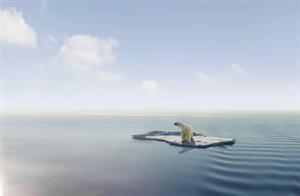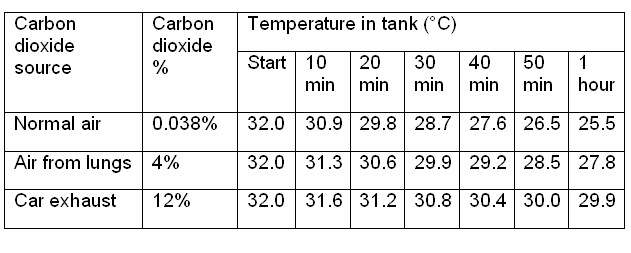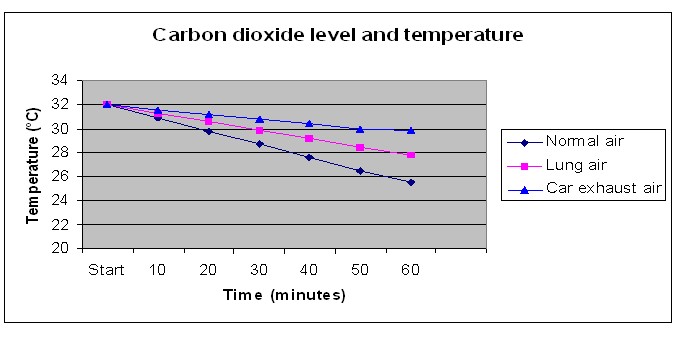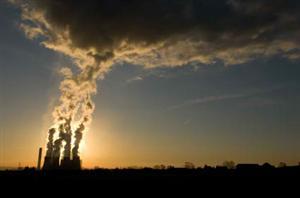| Complexity level: | 5 |
| Project cost ($): | 90 |
| Time required: | 1 hour to prepare, 2 hours for experiment |
| Material availability: | Easily found. Access to a car is required. |
| Safety concerns: | Be wary of carbon monoxide poisoning from the exhaust of the car. Conduct the experiment in a well ventilated garage. Adult assistance is required for the operation of the car. |
Hypothesis
Higher carbon dioxide content in the air will contribute to warmer temperatures.
Overview
Carbon dioxide and temperatures
Carbon dioxide is created when we burn fossil fuels like coal and gasoline. These fuels contain carbon, which combines with oxygen to produce carbon dioxide ?a by-product of the fuel burning process. This carbon dioxide is released into the atmosphere from factories, power plants, automobiles, and airplanes.
Carbon dioxide gas does not absorb energy directly from the sun. Instead, the earth releases heat energy which is absorbed by the carbon dioxide molecules. However, the carbon dioxide molecules do not store the absorbed energy for long and will release eventually release them. This energy can be directed towards outer space or return to the earth. It has been proven scientifically that the presence of carbon dioxide in the atmosphere will result in more energy being absorbed by the earth and the atmosphere of our planet, instead of the energy being released into outer space. This imbalance will cause the temperature of our planet to increase gradually by significantly over time.
Global warming
Growing industrialization, and aggressive deforestation and fossil fuel burning have led to increased levels of carbon dioxide in the atmosphere for more than twenty decades. Some of this carbon dioxide is used in photosynthesis by fauna, whilst some of it dissolves into the ocean and the rest remains trapped in our atmosphere. The past 100 years has recorded a 0.74 0C increase in global temperatures.
Scientific Terms
Materials
The materials required for ths experiment:
- 3 incandescent lamps
- 3 fish tanks with air tight covers and a small 15-20mm diameter opening
- 300 mm rubber hose 15-20 mm in diameter
- 1meter rubber hose 15-20 mm in diameter
- 1 air tight plastic bag
- 1 infrared thermometer
- stop watch
- masking tape
- 3 kg of black colored soil
- A car
- An assistant
Procedure
- For this experiment, the independent variable is the concentration of carbon dioxide, either from air blown from our lungs or smoke from a car exhaust. The dependent variable is the temperature of the air in the tank. This is determined by measuring the temperature using an infrared thermometer. The constants (control variables) are the starting temperature of the air in the tanks, the amount of type of soil at the base of the tanks and the volume of the tanks.
- The three water tanks are filled with a layer of black soil about 2 cm thick.
- A cover is placed over the first thank and masking tape is used to seal it in palce. It contains normal air.
- The second water tank is filled with air from our lungs. Using the rubber hose, air is blown into the tank from your mouth, into a small opening in the cover of the tank. The tank is then sealed air tight with the cover and masking tape.
- The third water tank is filled with air from the car exhaust. The open end of the plastic bag is wrapped around the exhaust of the car in such a way that the smoke from the exhaust will fill the bag. The plastic bag is fixed to the exhaust using masking tape. On the other end of the plastic bag, a small hole is made and the meter-long hose in inserted to a depth of about 5 cm. The hose is also fixed in place using the masking tape. The other end of the hose is inserted into a small opening in the tank cover, and the masking tape is used to seal the hose in its place. The car engine is started and left to run for 3 minutes with the help of the assistant and the smoke from the exhaust will be forced into the water tank. The tank is then sealed air tight with the cover and masking tape.
- Air from a person lungs a carbon dioxide concentration of about 4% whereas the smoke from the exhaust of a car will have about 12% carbon dioxide. The air around us has about 0.038% carbon dioxide.
- The incandescence lamps are placed about 1 meter above each of the 3 water tanks. The lamp is left on until the temperature inside the tanks reaches 32 0C. The lamp is then switched off and the temperature inside the tank is recorded every 10 minutes for 1 hour.

Results
The results show that the first tank with the normal air cools down the quickest and the third tank, with the air from the car exhaust, cools down the slowest.

Use the graph below to plot the results of above observation.

Conclusion
The hypothesis that a higher concentration of carbon dioxide in the air will slow down the rate at which the temperature of the air falls, is proven to be true. The heat released by the soil in the tank is captured by the carbon dioxide molecules. Some of the energy is returned to the soil and some of it is released out of the tank. Since the tank with the car exhaust gas had the highest concentration of carbon dioxide molecules, it demonstrated the slowest rate of cooling down.
The increase in carbon dioxide levels in the atmosphere has led to an increase in global temperatures. It is causing significant changes to weather patterns, the melting of polar ice (glaciers), and the rising of sea levels, causing islands to disappear. Furthermore, the increase in ocean temperatures has led to to the extinction of certain species of marine life.
Also consider
The experiment can also be repeated using water to replace the soil in the tank.
Try to perform this experiment by using a hair dryer to obtain a higher starting temperature. Observe the difference in the rate of cooling.
References
- Global warming - http://en.wikipedia.org/wiki/Global_warming
- How does carbon dioxide cause global warming? - http://www.pa.msu.edu/sciencet/ask_st/083194.html

